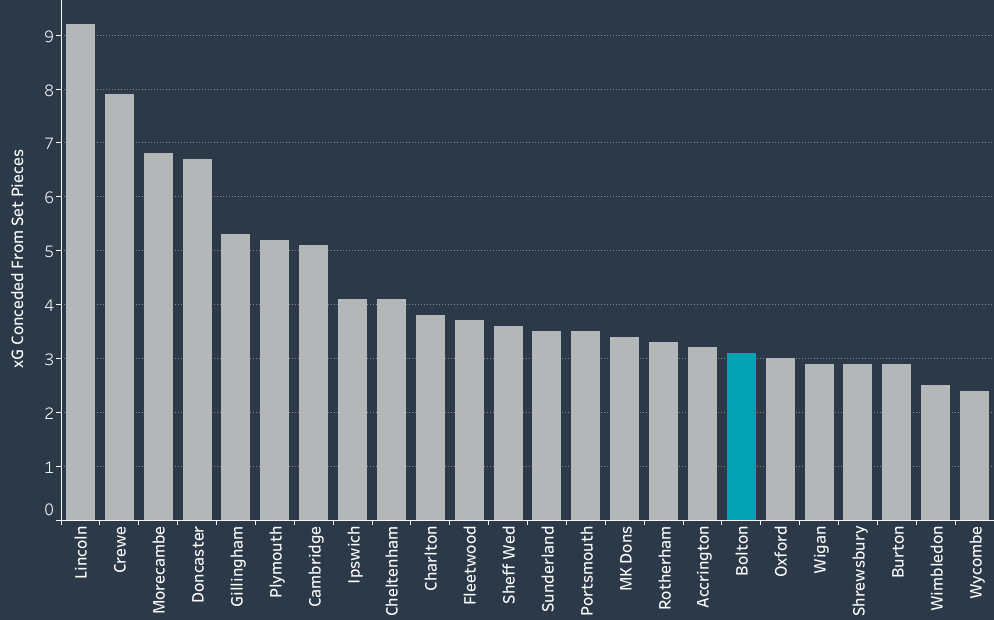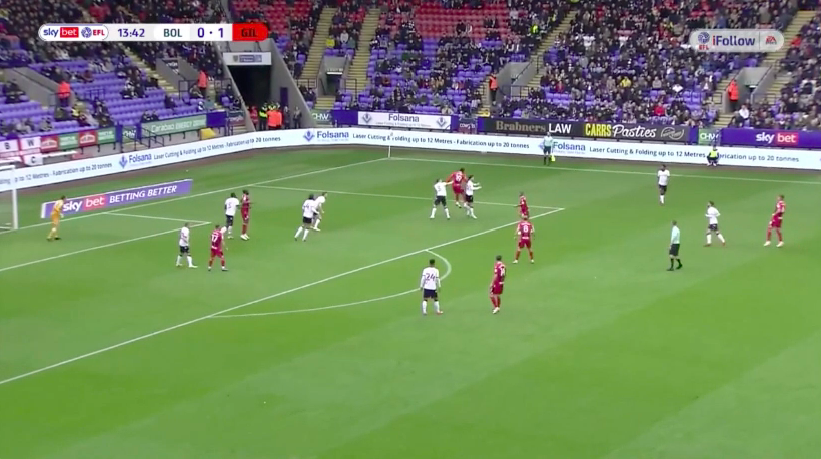In the past two games, Bolton Wanderers have conceded three goals from defensive set-pieces, once again raising the same questions they faced last season about their defensive fragility from dead ball situations. So is there something in this, or is it just a simple case of recency bias?
The headline number would suggest set-pieces are a problem area for this team – Wanderers are joint third for SP goals conceded so far this season with seven (Cheltenham are first having conceded nine and Accrington last having conceded just one). However two of these goals have been direct free-kicks (Twine for MK Dons and Leahy for Shrewsbury Town), which while disappointing, are hardly a sign of a defence poor at defending dead ball situations. Stripping out all direct free-kicks drops us down to joint sixth alongside three other teams (Crewe, MK Dons and Wycombe), not amazing but slightly more respectable.
*Set pieces = corners, free kicks and long throws
What is interesting is looking at the expected goals (xG) conceded from set-pieces in League One this season. According to the website The Analyst (which is fed by Opta), Wanderers are a lowly 17th for total xG conceded from set-pieces so far this season with just 3.1.

This suggests we’re not giving away too many out-and-out goalscoring opportunities. Admittedly, I think part of the reason we haven’t given up much xG from set pieces is we don’t give away many set pieces full stop. Due to our high possession stats we keep the opponents from having large amounts of possession in our half (and more specifically our defensive third), demonstrated by the fact we currently rank 2nd bottom for corners conceded per game with just 3.67, with only Wigan conceding fewer.
However, even looking at the average xG of each shot we concede from a set-piece (calculated by dividing our total xG conceded from SPs by the total number of shots we’ve faced against us at SPs), we can see that Wanderers are in the bottom third, restricting opponents to just 0.07xG when conceding a SP shot.

Despite the underlying numbers looking promising, there are clearly still areas that need improvement to avoid giving up the kind of soft goal we’ve witnessed recently.
Wanderers employ a hybrid zonal-man marking setup at corners and I think it’s generally pretty solid. The below is a screen grab from the Oxford game back in August (for no particular reason other than this was a good an angle as any to demonstrate).

- Sheehan (1) and Afolayan (2) defend against any short corners, with Sheehan also there to cut out a poorly struck, low corner.
- Isgrove (3) picks up the man on the edge, stopping the opponent having a shot at goal and hopefully getting to any balls cleared into that space before him.
- As two of the tallest players, Williams (6) and Johnston (7) are tasked with man marking the opposition’s two most dangerous aerial threats (normally their two tallest players).
- While Doyle (4) and John (5) pick up the remaining two opponents around the penalty spot.
- Jones (8) picks up the opposition player that stands in the way of Dixon, aiming to create a room for Dixon to manoeuvre in.
- Sarcevic (9, now replaced in this role by Lee) covers the front post area.
- Finally, Santos (10) doesn’t pick anyone up, instead covering the dangerous central area by the edge of the six yard box. I can’t be sure of exact dates but I believe it was around January time of last season that Santos was moved from man-marking to this zonal tactic. I don’t know if this is backed up by the stats but anecdotally it seemed to work last season (I don’t remember conceding many set piece goals during our impressive promotion run in the second half of the season) and seems to still be effective now. This setup gives Santos the freedom to go and attack the ball without being hindered by an opponent.
While this system helps to reduce the chances of the opposition winning a header in the most dangerous area of the box – the central space between the penalty spot and six yard line – it does appear to leave us vulnerable to a free runner at the back post.
With Santos in the zone on the edge of the six yard box and a centre-mid guarding the area by the front post, this leaves two opposition outfield players unaccounted for. One of these players will almost always be back on the halfway line as insurance against any Bolton counter attacks but as Wanderers rarely position a man upfield, this allows the other unmarked opponent to push up towards the box as there is no need for him to be back at the halfway line.
This is exemplified in the below clip from the same game as the screenshot above, Oxford’s Steve Seddon was presented with a good chance from a U’s corner, arriving late into the box unmarked.
The exact same situation occurred in the Rotherham game, however on this occasion the ball ended up in the back of the net, with Ben Wiles the beneficiary of being completely unmarked.
This goal definitely had the feel of Rotherham discovering this specific weakness and exploiting it perfectly.
Another concern is we seem to lack organisation and are slow to make defensive adjustments on the fly – things that could be dramatically improved with more work on the training ground. This showed against Gillingham, with their second goal coming as a result of a long throw and flick-on.
The glaring error here is that the 5’9″ Declan John is marking 6’3″ Vadaine Oliver (1) – arguably the most aerially dominant centre forward in the league. One of either George Johnston or MJ Williams should also be tight to Oliver to try and disrupt him getting first contact on the throw.

If Johnston goes to mark Oliver, Williams is then free to get tight to the eventual goalscorer Kyle Dempsey (2).
Another option is to have both Johnston and Williams tight to Oliver making it much harder for the target man to get first contact, which would then allow John and Lee to shut down the Gills players on the edge of the box.
Unfortunately none of this happens and, challenged by two of the smallest players on the pitch, Oliver unsurprisingly gets his head to the ball first and directs it into a dangerous area.

In my mind, Johnston does the right thing by attacking the ball and although he doesn’t direct it into the best of areas there doesn’t appear to be much else he can do – at the very least he gets it away from the immediate danger in the box.

The damage unfortunately, has already been done, with no one marking Dempsey he’s free to attack the ball, easily brushing off the half-hearted challenge from Kachunga and finishing smartly into the bottom left corner.
Evatt has spoken openly about his displeasure for working on set pieces but with a bit more drilling on the training ground, players would be better prepared to spot the developing danger, communicate this to teammates and then readjust quickly. I understand it’s not the most glamorous aspect of the game but it is a vital one, with seemingly every other team we face these days having a long-throw specialist and relying heavily on set-pieces for goal-scoring opportunities.
We also seem to suffer from a lack of height and possibly a lack of bravery and determination to be the first one to the ball, epitomised by Plymouth’s opener last week.
What’s striking is how small this side looks without Santos on the pitch. It’s also telling that the ball headed back across the box floats right across the area Santos usually defends. Bakayoko was substituted into Santos’ role for this game but clearly didn’t have the same desire to defend that zone, drifting out of the way as the corner is crossed in. Can we afford to be so reliant on one player to keep us solid at set-pieces?
Current recruitment strategy is, first and foremost, focussed on signing players with strong ball playing abilities and rightly so due to the possession-based system we play. However, this means we lack physically dominant players. I think this is the next stage of the team’s development and the next challenge for the recruitment team, finding those guys that can do both.
I wonder if this is an area in which Will Aimson can help – it’s only a small sample size but he looked good in his second half appearance against Gillingham. Whilst not having any corners or long throws to defend Aimson was extremely combative against Oliver in the air and showed purpose when attacking the ball.
There’s possibly an argument for reverting to three centre-backs and wing-backs to shore up the defence in both open play and dead ball situations, add in the injury issues at full-back and winger and the thought must surely be at the back of Evatt’s mind. I’ll certainly be waiting in anticipation for the release of the team sheet at two o’clock tomorrow.
